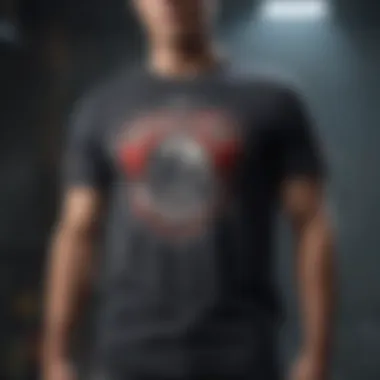Understanding Graphic T-Shirts: A Comprehensive Exploration


Intro
In the world of fashion, graphic t-shirts hold a unique place. They blend art, culture, and self-expression into a wearable form. This comprehensive exploration aims to understand the essence of graphic t-shirts. By examining their origins, design elements, and cultural impact, we can better appreciate their significance in contemporary apparel.
Graphic t-shirts first emerged as a popular fashion staple, but their history is rich and layered. They are more than just clothing; they serve as a canvas for creativity and a medium for messaging. This article seeks to dissect the various aspects of graphic t-shirts, from techniques used in design to their psychological and sociological implications.
The History of Graphic T-Shirts
Origin and Evolution
The inception of graphic t-shirts can be traced back to the late 1940s and early 1950s, a time when t-shirts transitioned from being mere undergarments to standalone fashion pieces. Initially, they were often adorned with simple logos or phrases, usually by brands or events. However, as the cultural landscape shifted in the 1960s, graphic t-shirts began to reflect the social movements of the time.
With the counterculture of the 1960s, artists started using t-shirts as a medium for political and social commentary. They provided a platform for youth to express dissent and ideals. Over the decades, the designs have evolved, moving from rudimentary prints to intricate illustrations created through various printing methods.
Milestones and Influences
Several milestones have shaped the graphic t-shirt industry. In the 1980s, pop culture began to influence design, as iconic musicians, movies, and television shows became sources of inspiration. Brands like Benetton and Threadless pioneered unique designs, fostering community engagement through user-submitted artwork.
The emergence of digital printing technology in the 1990s opened new doors for creativity. Photorealistic prints became possible, offering designers the ability to push boundaries.
Key Artists and Pioneers
In the realm of graphic t-shirts, certain individuals and groups have made a significant impact. Artists like Barbara Kruger and Keith Haring used their signature styles to create memorable t-shirt designs. Their work has transcended fashion, becoming cultural icons that represent artistic movements. Additionally, companies like Obey and Supreme have redefined streetwear, integrating graphic art into mainstream fashion.
Design Elements of Graphic T-Shirts
Types of Graphics
Graphic t-shirts can feature a variety of designs. These range from typography and illustrations to photographs and abstract art. Each type serves a different purpose, whether it's conveying a message, showcasing artistry, or reflecting personal style.
Printing Techniques
Different printing methods contribute to the quality and durability of graphic t-shirts. Common techniques include:
- Screen Printing: This traditional method uses a stencil to apply ink. It is cost-effective for bulk production, but limited in color gradients.
- Direct-to-Garment (DTG): A modern option that prints directly onto the fabric, allowing for intricate designs and color blending.
- Heat Transfer: Involves applying a design using heat. It is versatile but may lack longevity compared to other methods.
Cultural Significance
Graphic t-shirts serve as a mirror to societal values and identity. They reflect the interests and concerns of specific demographics. For example, t-shirts adorned with environmental messages or social justice themes indicate a cultural shift towards activism. Moreover, they become a way for individuals to communicate their beliefs and affiliations, making them an integral part of personal expression.
"Graphic t-shirts are not just fashion statements; they embody cultural narratives and personal beliefs."
By analyzing the various design elements and their cultural implications, we grasp the multifaceted role graphic t-shirts play in contemporary fashion. In the subsequent sections, we will explore more about market trends, consumerism, and their ongoing influence in the fashion world.
Preamble to Graphic T-Shirts
Graphic t-shirts occupy a distinct niche within the realm of apparel. They serve not just as garments but as canvases for art, messages, and identity. This section aims to lay the groundwork for understanding their multifaceted role in contemporary fashion. By defining graphic t-shirts and exploring their purpose and appeal, we can appreciate how these pieces transcend mere clothing.
Defining Graphic T-Shirts
Graphic t-shirts are characterized by designs printed on fabric, primarily cotton or cotton blends. The graphics can range from simple logos to complex artwork. These garments are often associated with specific cultures, subcultures, or ideologies. They may feature band names, artistic illustrations, political statements, or popular culture references. The medium of a graphic t-shirt provides a platform for self-expression and creativity.
The construction of these shirts allows for immense versatility. A graphic tee can be dressed down for a casual outing or paired with more formal items for a balanced look. It transforms a basic outfit into a statement, reflecting personal tastes and beliefs.
Purpose and Appeal
Understanding the purpose and appeal of graphic t-shirts is essential for comprehending their popularity. They provide wearers with a way to communicate their personalities. The designs often resonate with the values, interests, or identities of individuals. For instance, a graphic t-shirt featuring a favorite band immediately signals musical preferences, while one with a poignant slogan may reflect political or social stances.
The appeal of graphic t-shirts also lies in their accessibility. They are generally affordable and easy to find, making them a common choice among varying demographics. Additionally, they encourage a sense of belonging within groups. Wearing a shirt that represents a shared interest can foster connections between people. As such, graphic t-shirts are more than fashion statements; they foster community and dialogue.


"Graphic t-shirts can serve as a bridge between individual expression and collective identity, creating a cultural tapestry that is both diverse and interconnected."
Historical Context
Understanding the historical context of graphic t-shirts is vital in grasping their place in contemporary fashion. This section examines how graphic t-shirts originated and evolved alongside cultural shifts. Recognizing these historical elements provides insight into why graphic t-shirts remain relevant today. The influence of subcultures, movements, and social changes shape not only the graphic designs but also the manner in which these garments are perceived.
Origins of the Graphic T-Shirt
The graphic t-shirt traces its origins to the mid-20th century when it transitioned from being a utilitarian garment to a canvas for artistic expression. Initially, t-shirts served a practical role, primarily as undergarments or workwear. It wasn't until the 1950s that screen printing technology allowed for the easy addition of graphics. The integration of images and slogans transformed the t-shirt into a tool for personal and political expression.
In the 1960s, the graphic t-shirt gained momentum in youth culture, particularly among the counterculture movements. Icons like the peace symbol and messages urging societal change were common. The graphic t-shirt became a statement of identity, reflecting not only personal beliefs but also aligning wearers with the movements of the times.
Evolution Through Decades
Over the decades, graphic t-shirts have undergone continual evolution, paralleling societal and cultural dynamics. In the 1970s, the punk subculture popularized provocative and often confrontational graphics. Bands like the Sex Pistols and The Ramones used t-shirts as a medium to showcase rebellion, pushing against mainstream norms.
The 1980s ushered in a commercial boom for graphic t-shirts. Brands like Howard Stern's "T-Shirt Merchandising Inc." and Rolling Stone magazine's t-shirts allowed fans to display their affiliations. Striking designs started to capture the attention of the consumer market, leading to a more commercialized approach to graphic t-shirts.
In the 1990s and 2000s, graphic t-shirts took on a more mainstream appeal. They became staples in casual wear, seen on celebrities and influencers, which reinforced their status as a fashion item. Companies like Gap and Abercrombie & Fitch incorporated graphic tees into their collections, cementing their place in youth culture.
Today, the graphic t-shirt continues to evolve, often reflecting diverse themes from environmental activism to political statements. As different subcultures intersect, the designs become an even richer tapestry of expression. This ongoing evolution highlights the versatility and adaptability of graphic t-shirts, making them an enduring element of fashion.
Design Elements
Design elements play a crucial role in determining the appeal and effectiveness of graphic t-shirts. These elements combine functionality and artistry to create garments that not only look good but also convey messages or represent identities. An effective design can attract consumers, evoke emotions, and serve as a means of personal expression. This section explores common graphics and themes, color schemes, and typography, essential ingredients that contribute significantly to the identity of graphic t-shirts.
Common Graphics and Themes
Graphic t-shirts often display various graphics and themes that resonate with diverse audiences. Here are some notable examples:
- Pop Culture References: Icons from movies, music, and television frequently inspire graphic t-shirt designs. For instance, a shirt featuring a vintage band logo can appeal to music lovers and communicate nostalgia.
- Social and Political Statements: Many designs reflect societal issues or movements. These graphic t-shirts serve as wearable statements, allowing the wearer to express their beliefs, such as environmental awareness or social justice.
- Artistic and Abstract Designs: Abstract patterns or unique art styles can create visually intriguing pieces that attract attention in everyday settings. Artists often collaborate with clothing brands to produce limited editions.
- Humor and Wit: Some t-shirts utilize clever wordplay or humorous graphics. Such designs tend to resonate with casual wearers looking to express their playful sides.
Understanding these themes helps brands connect with their target audience. It also guides consumers in choosing designs that reflect their values and interests.
Color Schemes and Typography
Color schemes and typography work hand in hand to set the tone of a graphic t-shirt. The right combination can enhance the overall message and visual appeal.
Colors in Graphic Design:
- Bright and Bold Colors: These are often eye-catching and popular among younger demographics. They can convey excitement and energy.
- Muted Tones: Such colors can suggest sophistication or minimalism. They generally appeal to an audience looking for subtlety.
- Contrasting Colors: They are frequently used to make graphics pop. High contrast can draw attention to specific elements of a design.
Typography Considerations:
- Fonts: The choice of font greatly influences how a message is perceived. Bold fonts can emphasize strength, while script fonts may convey elegance.
- Readability: Clear lettering is essential, especially in designs meant to convey messages. If the text is hard to read, the full impact of the design may not be felt.
- Placement: Typographic elements can vary in placement—from centered text to asymmetrical layouts. This flexibility allows for creative expression and uniqueness in designs.
"Effective graphic design is not just about being visually appealing; it’s about communicating a message clearly and compellingly."
Consumers and creators alike should pay attention to these components as they navigate the expansive world of graphic t-shirts.
Printing Techniques
Printing techniques play a crucial role in the production of graphic t-shirts. They determine not only the quality and longevity of the designs but also their visual appeal and texture. Understanding these methods helps in making informed decisions as a consumer or a producer. Different techniques can yield diverse results, affecting everything from cost to sustainability. Each option has its advantages and drawbacks, which influences the final product.
Screen Printing
Screen printing is one of the oldest and most commonly used methods for creating graphic t-shirts. In this technique, a stencil is created for each color, and ink is pushed through a mesh screen onto the fabric. This allows for vibrant colors and durable prints that withstand multiple washes.
"Screen printing is known for producing high-quality, lasting images that can handle the rigors of daily wear and tear."


Some benefits of screen printing include:
- Cost-Effectiveness: Ideal for bulk orders, as the setup costs are spread out over many shirts.
- Durability: Prints typically last longer than other methods, making it popular for promotional and branded apparel.
- Vibrancy: Capable of producing bright colors and intricate designs.
However, there are considerations:
- Limited Color: Each color requires a separate screen, which can raise costs for multi-colored designs.
- Setup Time: Initial setup can be time-consuming, not suitable for one-off designs.
Direct-to-Garment (DTG) Printing
Direct-to-Garment printing involves using specialized inkjet technology to print images directly onto fabric. This method allows for complex designs to be achieved quickly and with high detail. DTG printing has grown in popularity due to its flexibility.
Advantages of DTG Printing:
- Detail and Complexity: Capable of printing photorealistic images with gradients and vivid colors.
- Eco-Friendly: Often utilizes water-based inks, which are less harmful to the environment compared to plastisol inks.
- On-Demand Production: Suitable for small runs or one-off custom designs, reducing excess inventory.
But there are some limitations:
- Durability: Prints may fade faster than those made with screen printing if not cared for appropriately.
- Cost-Prohibitive for Bulk: Not as cost-effective when printing large quantities due to slower processing time.
Heat Transfer Methods
Heat transfer methods involve printing a design onto special transfer paper, which is later applied to the t-shirt using heat and pressure. This method can produce a wide variety of designs, making it popular for custom orders.
The strengths include:
- Versatility: Suitable for various materials and numerous design formats.
- Ease of Use: Can be performed with basic heat press equipment, making it accessible for small businesses or individual crafters.
- Quick Turnaround: Faster than screen printing for small batches or individual shirts.
Nonetheless, there are considerations as well:
- Durability Issues: Transfers may peel or crack over time, especially with improper washing.
- Quality Variability: The final look can vary greatly based on the quality of the transfers used.
Each printing technique offers a unique set of characteristics that should be evaluated based on the intended use of the graphic t-shirt. Every choice comes down to balancing cost, quality, and environmental impact.
Cultural Significance
The cultural significance of graphic t-shirts extends far beyond simple fabric and designs. They act as a canvas for personal expression and social commentary, resonating with diverse audiences. These garments are a reflection of cultural shifts, societal values, and individual identities. The way individuals choose to wear graphic t-shirts provides insight into their values, beliefs, and affiliations.
Graphic T-Shirts in Subcultures
Graphic t-shirts have found a pivotal role in various subcultures, bridging distinct communities with shared interests. From punk rock to hip-hop, each subculture has embraced this clothing item, often using it to communicate group identity.
For instance, punk subculture utilized graphic t-shirts to express dissent and rebellion against mainstream norms. The bold graphics frequently featured band logos, political messages, or artwork that challenged societal expectations. In the hip-hop community, graphic t-shirts serve as a means of showcasing artists, styles, and affiliations. They often become a part of the everyday uniform, representing connection to culture and music.
It's essential to recognize how these shirts contribute to belonging. The act of wearing a specific graphic can signal membership and create an unspoken bond among individuals within the same subculture. This function of graphic t-shirts highlights their importance not just as clothing, but as symbols of unity and identity.
Expression and Identity
Graphic t-shirts serve as powerful tools for self-expression. They allow individuals to communicate aspects of their beliefs and personality without uttering a single word. Through graphics, colors, and slogans, wearers articulate their passions, interests, and identity.
The choice of a graphic t-shirt can reflect a wide array of sentiments, including humor, art appreciation, social movements, and personal beliefs. For instance, a t-shirt featuring artwork from a local artist can convey a sense of pride in community, while one that promotes environmental awareness indicates a commitment to sustainability.
"Wearing your heart on your sleeve can be literal when it comes to graphic t-shirts. They provide instant visibility for what individuals stand for."
Additionally, these shirts have evolved as platforms for marginalized voices. Many independent brands are using graphic t-shirts to amplify representation and support social justice. Through thoughtful design, they encourage conversations around critical issues, sparking awareness and activism.
In summary, graphic t-shirts hold considerable cultural significance. They serve not only as fashion statements but also as powerful mediums for personal and collective expression. Understanding this cultural role enhances our appreciation for graphic t-shirts as crucial components of contemporary identity and style.
Market Trends


Understanding market trends in graphic t-shirts is essential for anyone interested in fashion and design. This section explores the dynamics in this niche clothing segment, revealing how various forces shape consumer preferences and industry offerings.
The Rise of Niche Brands
Niche brands have surged in popularity, catering specifically to subcultures and varying consumer interests. These brands often focus on distinct themes, styles, or messaging that resonate with targeted audiences. They provide alternative options to mainstream offerings, allowing for personalization and unique expressions of identity.
For example, brands like BANDIT and Activist Tees have emerged to address particular causes or lifestyles. Their offerings often reflect values that appeal to specific groups, thus creating a loyal customer base. The rise of these niche brands emphasizes consumer desire for individuality, authenticity, and connection to personal interests.
This trend has been facilitated by the accessibility offered by online shops and platforms, making it easier for entrepreneurs to reach audiences directly.
Impact of Social Media
Social media plays a pivotal role in shaping market trends for graphic t-shirts. Platforms such as Instagram, Pinterest, and Facebook enable brands, especially niche ones, to promote their products effectively. They allow for visual storytelling, showcasing unique designs that can capture the attention of potential buyers.
Users often share images of their graphic t-shirts, creating organic marketing that traditional advertising cannot match. As a result, hashtags related to graphic t-shirts can spark viral trends, leading to rapid shifts in consumer preferences.
Additionally, collaborations between influencers and niche brands have led to increased visibility and market penetration. Influencers curate their brands, aligning with niche products that speak to their audiences, thereby influencing what is considered fashionable.
As fashion becomes more connected to social media dynamics, brands must adapt to consumer behavior and engage in authentic conversations that foster loyalty.
In summary, the importance of market trends in graphic t-shirts can’t be overstated. They reflect broader changes in consumer attitudes, preferences, and cultural movements, ultimately guiding brands in their design and marketing strategies.
Environmental Considerations
The discussion surrounding graphic t-shirts inevitably includes a critical examination of their environmental impact. As consumers become increasingly aware of the consequences of fast fashion, understanding the environmental considerations related to graphic t-shirts has become more relevant. The production processes, materials used, and consumer behaviors can significantly contribute to ecological challenges, yet there are also emerging practices aimed at sustainability. This section delves into these aspects, aiming to highlight the pressing need for conscious choices in the fashion industry and the responsibility of both producers and consumers.
Sustainability in Production
Sustainability in the production of graphic t-shirts is a multifaceted issue. The traditional methods of manufacturing often employ harmful chemicals and generate substantial waste. Most graphic t-shirts are made from cotton, which requires vast amounts of water and often uses pesticides that harm local ecosystems. However, there is a shift towards sustainable practices that prioritize environmental health.
Here are a few noteworthy approaches:
- Organic Materials: Brands are increasingly using organic cotton, which reduces the use of harmful pesticides and fertilizers.
- Eco-Friendly Inks: Water-based inks or inks derived from natural sources lessen environmental impact compared to standard plastisol inks.
- Recycling Programs: Some companies have implemented take-back programs, encouraging consumers to return old t-shirts for recycling or repurposing.
- Local Production: Reducing transportation emissions by manufacturing locally can mark a significant reduction in a product's carbon footprint.
The transition to sustainable practices not only aids the environment but also appeals to a growing market of eco-conscious consumers. This blend of ethics and aesthetics presents an opportunity for brands to stand out in a crowded market.
Consumer Responsibility
Consumer responsibility is vital in shaping a more sustainable future for graphic t-shirts. The choices made by buyers directly influence production methods and brand practices. Here are some key ways consumers can take responsibility:
- Research Brands: Consumers should seek out brands that prioritize sustainable practices, from sourcing to manufacturing.
- Buy Less, Choose Wisely: Opting for quality over quantity can mitigate the reliance on fast fashion, promoting a culture of durability.
- Embrace Second-Hand Markets: Thrift stores and online platforms often provide an abundance of graphic t-shirts, giving them a second life while reducing waste.
- Advocate for Change: Engaging in conversations about sustainability and holding brands accountable can drive market shifts towards more responsible practices.
Ultimately, conscious consumerism not only benefits the environment but also fosters a deeper connection between individuals and the clothing they choose to wear.
"Every purchase is a vote for the kind of world we want to live in."
These actions underscore a collective effort to create a fashion ecosystem where graphic t-shirts can exist without compromising environmental integrity. Addressing sustainability in both production and consumption serves as a profound step toward mitigating the industry's ecological impact.
Closure
In this section, we reflect on the significance of graphic t-shirts and their evolving role in contemporary culture. Graphic t-shirts have transcended their basic function as clothing. They embody intricate narratives about identity, creativity, and societal shifts. The exploration throughout the article illuminates the multifaceted nature of graphic t-shirts, emphasizing their importance in artistic expression and social commentary.
Reflection on Graphic T-Shirts' Future
The future of graphic t-shirts looks promising yet complex. As sustainability takes center stage, consumers are increasingly demanding eco-friendly options. Brands are likely to innovate in both materials and printing processes to meet these expectations. Furthermore, the rapid advancement in technology may lead to even more creative designs and customization options. This evolution will not only enhance personalization but also allow for a greater variety of themes and graphics.
In addition, the integration of digital platforms for design sharing and sales is likely to redefine the graphic t-shirt market. As global and local trends continue to merge, graphic t-shirts may serve as powerful vehicles for cultural exchanges. Such developments will undoubtedly influence how graphic t-shirts are perceived and utilized within fashion.
Final Thoughts on Impact and Expression
Graphic t-shirts are more than just fabric and ink. They serve as canvases for personal expression and social commentary. Each design tells a story or conveys an idea, resonating with individuals on personal and societal levels. As they continue to adapt to shifting cultural landscapes, the impact of graphic t-shirts on fashion and identity remains vital.
The importance of understanding graphic t-shirts cannot be overstated. They are branches of culture and fashion that intertwine stories of generations, movements, and societal changes. For adventure seekers and extreme sports enthusiasts, these t-shirts often reflect values like freedom, exploration, and resilience. Such attributes deepen their significance in the apparel market and societal discourse.
In essence, the journey of graphic t-shirts is far from over. As they evolve, so too does their ability to inspire and challenge norms. These garments promise to remain a pivotal element in fashion, culture, and personal identity.







